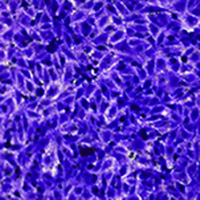Downregulation of Williams syndrome transcription factor (WSTF) suppresses glioblastoma cell growth and invasion by inhibiting PI3K/AKT signal pathway

Submitted: 25 March 2021
Accepted: 23 October 2021
Published: 17 November 2021
Accepted: 23 October 2021
Abstract Views: 613
PDF: 412
HTML: 30
HTML: 30
Publisher's note
All claims expressed in this article are solely those of the authors and do not necessarily represent those of their affiliated organizations, or those of the publisher, the editors and the reviewers. Any product that may be evaluated in this article or claim that may be made by its manufacturer is not guaranteed or endorsed by the publisher.
All claims expressed in this article are solely those of the authors and do not necessarily represent those of their affiliated organizations, or those of the publisher, the editors and the reviewers. Any product that may be evaluated in this article or claim that may be made by its manufacturer is not guaranteed or endorsed by the publisher.
Similar Articles
- E. Carabajal, N. Massari, M. Croci, D. J. Martinel Lamas, J. P. Prestifilippo, R. M. Bergoc, E. S. Rivera, V. A. Medina, Radioprotective potential of histamine on rat small intestine and uterus , European Journal of Histochemistry: Vol. 56 No. 4 (2012)
- S.A. Ferreira, J.L.A. Vasconcelos, R.C.W.C. Silva, C.L.B. Cavalcanti, C.L. Bezerra, M.J.B.M. Rêgo, E.I.C. Beltrão, Expression patterns of α2,3-Sialyltransferase I and α2,6-Sialyltransferase I in human cutaneous epithelial lesions , European Journal of Histochemistry: Vol. 57 No. 1 (2013)
- Yong Jiang, Chun-hui Xu, Ying Zhao, Yun-han Ji, Xin-tao Wang, Ying Liu, LINC00926 is involved in hypoxia-induced vascular endothelial cell dysfunction via miR-3194-5p regulating JAK1/STAT3 signaling pathway , European Journal of Histochemistry: Vol. 67 No. 1 (2023)
- J. Knabl, A. Vattai, R. Hüttenbrenner, S. Hutter, M. Karsten, U. Jeschke, RXRα is upregulated in first trimester endometrial glands of spontaneous abortions unlike LXR and PPARγ , European Journal of Histochemistry: Vol. 60 No. 4 (2016)
- C. Loreto, L. E. Almeida, M.R. Migliore, M. Caltabiano, R. Leonardi, TRAIL, DR5 and caspase 3-dependent apoptosis in vessels of diseased human temporomandibular joint disc. An immunohistochemical study , European Journal of Histochemistry: Vol. 54 No. 3 (2010)
- Qiong Lin, Tianxing Yu, Xiaohua Li, Xin Lin, Yong Fan, Liyu Xu, Umbilical cord mesenchymal stem cells inhibited inflammation of bronchial epithelial cells by regulating Hedgehog pathway , European Journal of Histochemistry: Vol. 67 No. 4 (2023)
- L.V. Renna, R. Cardani, A. Botta, G. Rossi, B. Fossati, E. Costa, G. Meola, Premature senescence in primary muscle cultures of myotonic dystrophy type 2 is not associated with p16 induction , European Journal of Histochemistry: Vol. 58 No. 4 (2014)
- F. Frontalini, D. Curzi, F.M. Giordano, J.M. Bernhard, E. Falcieri, R. Coccioni, Effects of lead pollution on Ammonia parkinsoniana (foraminifera): ultrastructural and microanalytical approaches , European Journal of Histochemistry: Vol. 59 No. 1 (2015)
- H. Zhang, P. Liu, S. Wang, C. Liu, P. Jani, Y. Lu, C. Qin, Transgenic expression of dentin phosphoprotein inhibits skeletal development , European Journal of Histochemistry: Vol. 60 No. 1 (2016)
- S. Gurzu, M. Krause, I. Ember, L. Azamfirei, G. Gobel, K. Feher, I. Jung, Mena, a new available marker in tumors of salivary glands? , European Journal of Histochemistry: Vol. 56 No. 1 (2012)
<< < 2 3 4 5 6 7 8 9 10 11 > >>
You may also start an advanced similarity search for this article.

 https://doi.org/10.4081/ejh.2021.3255
https://doi.org/10.4081/ejh.2021.3255











